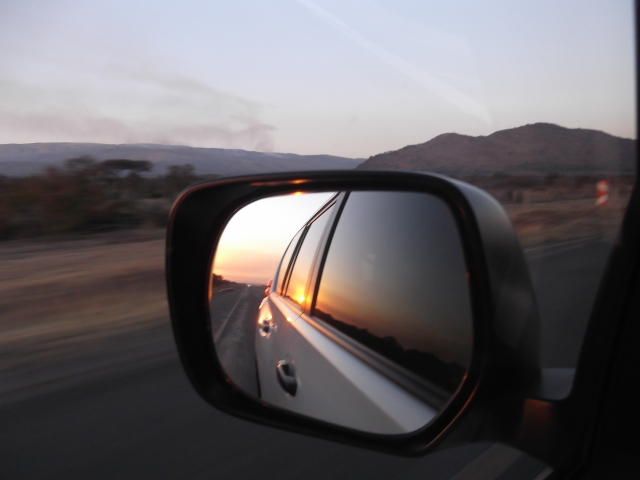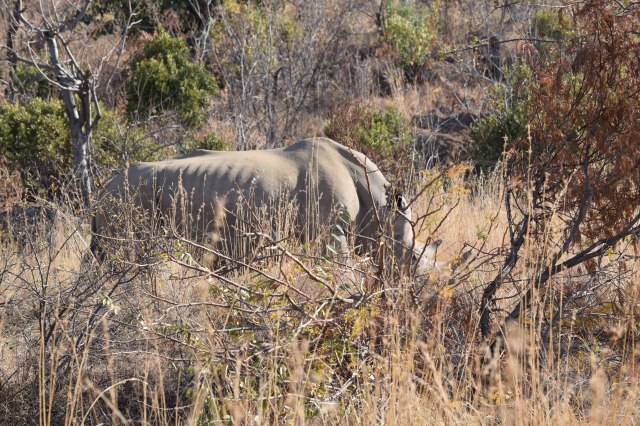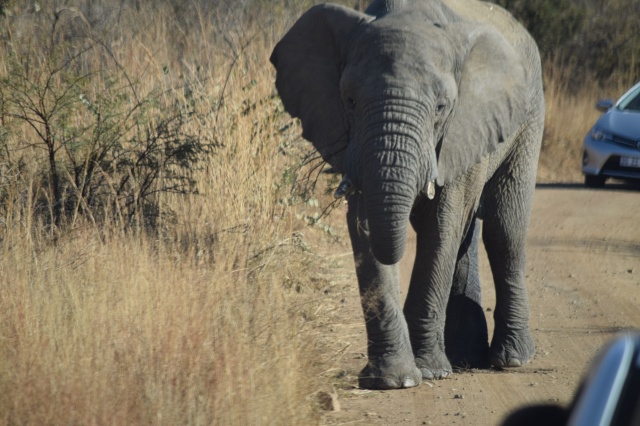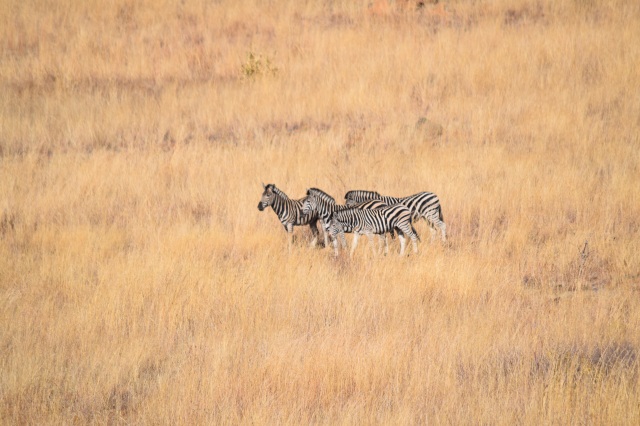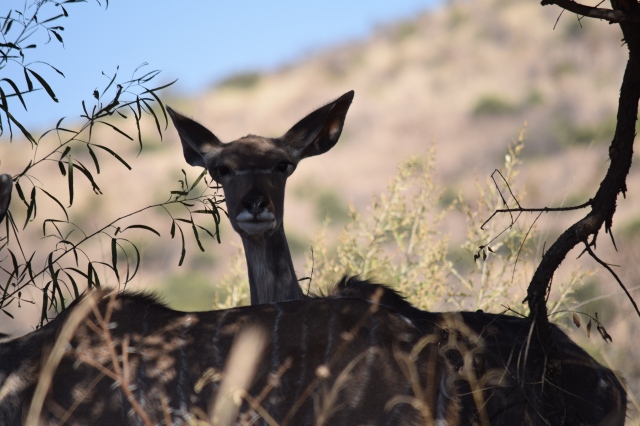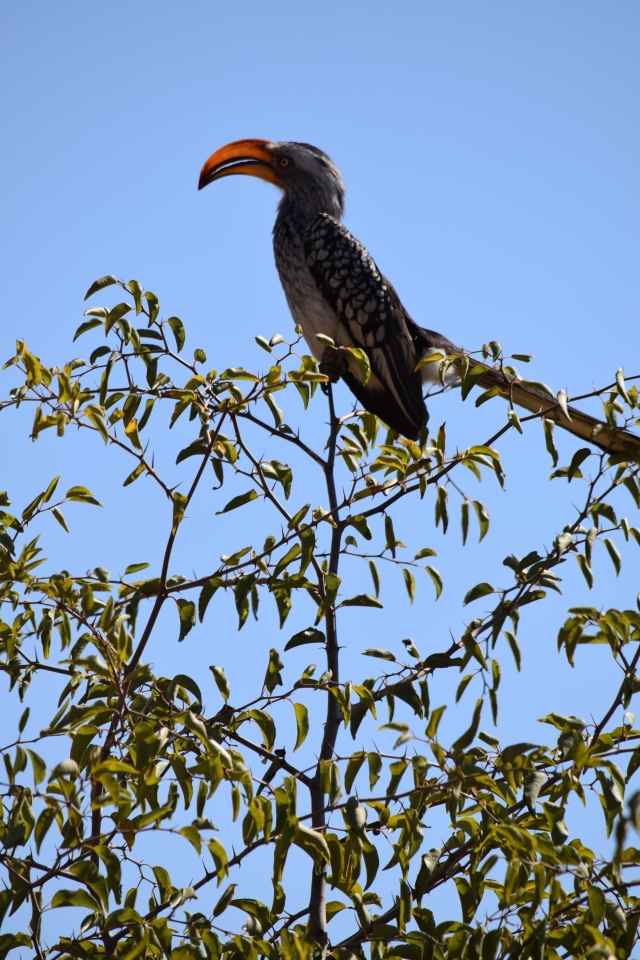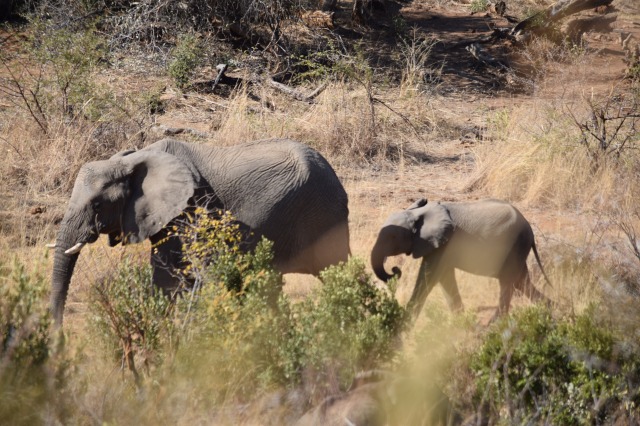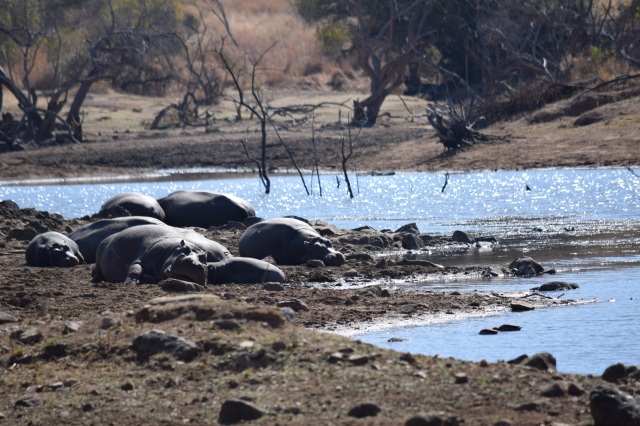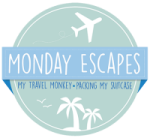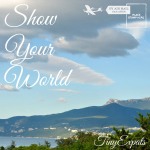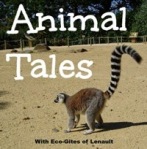I won’t pretend to be an expert on Kruger, one of the largest and best-known national parks in the world. There must be millions, if not squillions, of words already written about this amazing place – not to mention the many photographs taken and published by Kruger-lovers around the globe.
No, I certainly am no expert, after all, we have only been once and then for only six days. However, as a total beginner, there were a few things I would have found useful to know before we left – especially for those who, like us, were taking children. So, here is my guide to how to survive a Kruger self-drive holiday with kids.
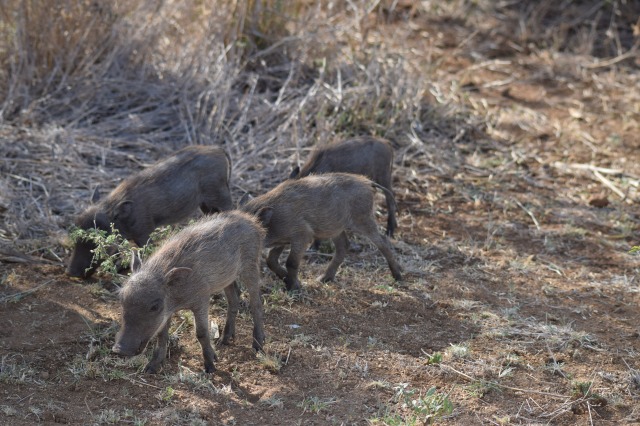
Warthoglets – December is a great time to go to Kruger to see lots of newborn animals
Plan plan plan
The first thing you need to do before booking your trip to Kruger is to plan ahead. A long way ahead. If you are self-driving and staying in SANPark (South African National Parks) restcamps (as we did), you may need to book your accommodation up to a year in advance. If you are staying in private lodges (which are a lot more luxurious but not what this particular post is about) you can probably book closer to the date of travel. But the restcamps are extremely good value for money starting as low as £20 a night – which is what makes Kruger so accessible. And so affordable.
You may be stuck with certain dates to visit the park/South Africa depending on the age of your kids. But even so it is worth looking at what different times of the year are like: the summer (the northern hemisphere’s winter) can be extremely hot in South Africa: temperatures in Kruger have been reaching up to 43 degrees celcius this week. The winter tends to be a lot chillier at night but can still have lovely sunny days. There also tends to be less vegetation, making it easier to spot wildlife. School holidays will always be the busiest time – take a note of South African school holidays.

Where to stay?
So once you have decided when you want to visit Kruger, I suggest you start thinking about how long you want to be “on safari” for and which camps you want to visit. To help with this, have a look at the SANParks website – their Kruger section is a wealth of information, including forums where you can ask any question you like. I also used guidebooks, maps, personal recommendations, TripAdvisor…..
Even so, it can be incredibly confusing to decide where to go. For a start, think about distances. As a rule of thumb you will probably travel at about 25 mph in the park – speed limits are low on all the roads and you will have many interesting things to stop and look at along the way. Five or six hours in a car at a time is enough for most people, so you probably won’t want to travel too often between distant camps.

Braai’ing at the Oliphants rest camp
For our first trip we decided to stay at just three camps – Lower Sabie for one night, Oliphants for two nights, Satara for two nights and then back to Lower Sabie for another night. This gave us the chance to explore the more popular southern part of the park, which is best known for having a higher number of animals. We thought with children it was better to see as much as possible – going for any length of time without sitings could get a little tedious for them.
In terms of what is on offer at the restcamps, the SANPark website has all the details. Accommodation includes very nice rondevals and bungalows (ranging from 2-bed up to larger family guesthouses), cheaper rooms without kitchens, permanent tents and campsites. We always went with the rondavels, which each had bedrooms, bathrooms, fans and aircon, kitchenettes and somewhere to sit outside with a cold beer and watch the sunset. They weren’t luxurious, but they were comfortable and clean.
Location of the rooms can also be important. In some camps, for example, you can stay right on the perimeter with fantastic views of rivers, out onto the park, or the sun setting in the evening. Take a look at the maps to see where each bungalow is placed and chose the one closest to the views. At least, that is what my recommendation would be!
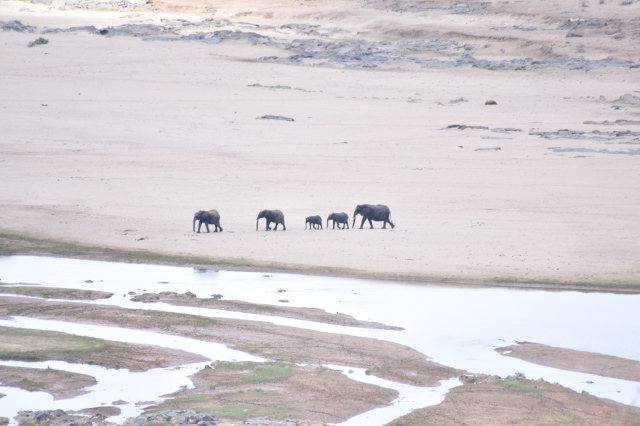
Elephants on their way to the Oliphants river, viewed from our bungalow
The bungalows all come equipped with plenty of kitchen equipment – pans, cutlery, plates, various types of glasses, Braai tongs etc. Also dish clothes, washing up liquid, all sheets and towels…..the only thing they didn’t have which we would have found very helpful was a colander for draining pasta and potatoes…
Eating?
As with all holidays, mealtimes are very important. As we were self-catering we knew we would have to bring a certain amount of food into the park with us. We also didn’t have much room in the car so we decided to divide our meals between cooking for ourselves and eating in the restaurants in the camp (all the ones we ate at were run by the local franchise Mugg and Bean, which is generally pretty good). We had a large ice box, bringing a ready cooked meal for our first night and then some frozen meat for subsequent nights. We were able to re-freeze ice packs every night as each kitchenette included a fridge freezer.
There are shops selling food in the camps but they are quite basic so don’t rely on them to stock up too much. They did have quite a lot of wine and beer choice though! We bought bread, rusks, frozen yoghurt, milk and other bits and pieces in the rest-camp shops and also restocked on the one occasion we left the park to try and get our car fixed (a long story!).

Cheeky monkey at a picnic stop
Most days start early so we made sure we had coffee, hot chocolate, flasks, rusks etc so could stop for a coffee break after an hour or two at one of the picnic or get-out stops. Many South Africans have a full-on cooked breakfast mid-morning but as nice as it looked, it also seemed like quite a faff. Sitting with a cup of coffee or picnic lunch watching elephants washing in a river below was certainly worth doing though!
Getting around
Of course if you are doing a self-drive safari, you need something to drive around in. We drove our seven-seater car up from Pretoria as my parents were staying so we needed the space. If you are coming from overseas, you will need to hire a car. The roads in Kruger are excellent, all either tar or relatively smooth gravel (with some corrugated parts). You won’t need a four wheel drive but I would get the most comfortable car you can afford – you will be spending a lot of time in it!
Many people fly into Johannesburg and hire a car from the airport. If you do this, be aware that it is a long drive to Kruger so you might want to plan to stay a night in Joburg before you leave for the park or along the way. There are lots of places on the road to stop to eat, stock up with food and fill your car with petrol. There are also petrol stations at some of the larger rest camps.
Another choice is to fly to one of the airports near Kruger, from which you can pick up a hire car. This cuts out a lot of travelling if you are only in South Africa for a short time, but of course adds cost for the extra flight.

You won’t need a big car to see the big animals….
We did come across one breakdown in the park, plus heard stories of a few more, so make sure you know what to do if you did get car trouble. There is a mechanic based in the park (at Lataba) who will come to you if necessary. We know this because the airconditioning in our car stopped working halfway through the holiday. We did try and get it fixed but in the end we just went with the open-window option. It probably made for a better experience as we really were up close with the sounds, sights and even smells of the bush! But make sure you have some way of communicating and keep the numbers of the camps and parks with you at all times, particularly as you get closer to dark.
Also make sure you get a good map and/or route book. We used this one that I bought in Pretoria before we left for Kruger – it details every single road in the park, with information about what you can see and a star rating to give you help in planning your route. There are smaller and cheaper versions available to buy in the park itself.
You can also book game drives and walks (although the walks are generally only for children aged over 12) from the camps at very reasonable prices. The evening and night drives in particular can be a great way to see the park after dark as the camp gates close to the public after sunset.

The sun sets on 2015
What will you see?
This I can’t tell you because this is the beauty of the self-drive safari. You just never know what is round every corner – it could be an empty road, or it could be a road full of baboons or zebras!

You will almost certainly see plenty of these:

But hopefully you will also see some of these

As well as the above, plus another two excellent leopard sightings, we also saw plenty of lions – including two who just trotted out of the bush ahead of us and disappeared up the road with us following slowly behind; two serval; lots of hyena, countless hippos, giraffes, zebras, wildebeest, buffalo, elephants, impalas, steenbok, kudu, waterbuck, crocodiles, monkeys, baboons, mongoose……it really was non-stop wildlife.
My parents, who came with us, are big bird fans and managed to clock up around 120 different types of birds during the week. Even though the rest of us aren’t so keen, there were some birds that we all agreed were interesting enough to stop for:

Ground hornbills – sort of half turkey, half crows….with red faces….
And what about the kids?
Of course, all parents know that when they plan a holiday they have to make sure the children will be happy – or everyone will be miserable! A self-drive holiday like this can be difficult with small kids: generally you will be in the car for hours at a time; you can only get out at designated spots so no unscheduled toilet breaks; and there isn’t an awful lot to do at the camps in between drives. Here are my tips for taking kids on a self-drive safari with you:
- Don’t take your children at all unless you know they are ready for it. I don’t want to give an age as every child is different, but I wouldn’t have taken our just-turned eight year old before this year.
- Book camps with pools, especially in the summer. We found a dip in the pool after a game drive was a fantastic way to cool off and also for the kids to let off steam. Some of the pools were less busy, and nicer, than others – our personal favourite was the one at Oliphants as it wasn’t too crazy. Satara, on the other hand, was bursting with people. We were there at the busiest time though.
- Have lots of pens, paper, books, tablets etc in the car to keep your children amused when pickings are sparse outside the window.
- Don’t forget snacks, especially for the early morning drives. We found the behavour of our youngest improved dramatically once we had given her something to eat in the morning. Always keep lots of water in the car too. We took hot chocolate to make for them at the morning stops when the adults had coffee.
- Invest in some child-friendly binoculars and possibly a camera for them before the trip. Make sure they have got the photo they need before moving on – we learned from our mistakes that to do otherwise could lead to tantrums! There are bird and animal-spotting guides for children available in the shops at the rest camps, as well as lots of books, some games etc.
- Remember that malaria can be an issue in this part of South Africa. There are generally more mosquitos in the summer when it usually rains more (although not this year, when we are in the middle of a pretty devastating drought – which did at least keep mozzies to a minimum). Some people chose not to take any prophylactics at all and just use spray and cover up as much as possible. We decided to use the pills, but certainly speak to a health professional about it before you chose what to do.
- Be flexible!! I know this is such a cliche but this should be the case for every holiday with children and in particular something like this. You may want to get up at the crack of dawn every day to get the best chance to see animals; but it might not work out if your kids won’t get out of bed. You could take it in turns to stay behind with the children if there are enough of you. If the children are getting grouchy in the car, try and find a place to get out for a stop and let them move around a bit. If this doesn’t help, consider calling it a day.
- If things do go a bit pear-shaped, remember that you are still having an experience that you will almost certainly all look back on fondly. Your kids will be gaining so much from being in a place like Kruger and observing the animals in their natural habitat that you can forgive the odd difficult moment knowing that the overall benefit to all will be immense. Kruger is a very special place and any child who gets to go there is very lucky indeed :)

Enjoy the small things
Finally, I wanted to mention something that I think is so important to your overall enjoyment of a self-drive safari, which is not only to look out for the “big stuff” (the predators, the Big 5, the rhinos etc) but also to enjoy the small moments. Some of our favourite memories from our holiday included watching a newborn wildebeest calf wobble to its feet as the vultures and jackals circled, then trot off after its mother leaving disappointed scavengers in its wake; a water hole surrounded by frustrated zebra desperate for a drink but unable to get close to the water thanks to the group of hyenas who had taken up residence in the pool; and a group of monkeys including tiny babies bouncing all over Satara rest camp early one morning like a group of rowdy pre-teens, the older ones jumping up and down the trees and rough-and-tumbling with each other, the youngsters mimicking their elder siblings from a much safer height…..

Baby monkeys learning to play
All in all, it was a magical holiday. Not only did we see a fantastic variety of wildlife as well as plenty of beautiful scenery, we also spent some really quality family time together away from all distractions like phones and computers (there is wifi and signals at the camps but I decided just to turn my phone off for the duration!). It was a real escape, a perfect opportunity to recharge our batteries and the best possible start to our first full year in South Africa.
I have already started planning our next trip there!
Have you been to Kruger, or on a self-drive safari? Do you have any tips to add? If you have any questions please don’t hesitate to ask me :)
















